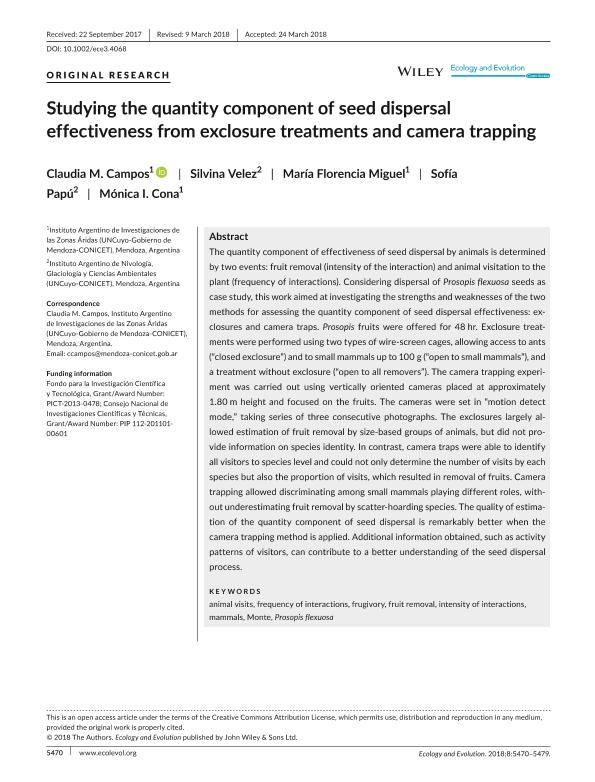Mostrar el registro sencillo del ítem
dc.contributor.author
Campos, Claudia Monica

dc.contributor.author
Velez, Silvina

dc.contributor.author
Miguel, María Florencia

dc.contributor.author
Papú, Sofía

dc.contributor.author
Cona, Monica Ines

dc.date.available
2019-11-12T12:43:48Z
dc.date.issued
2018-06
dc.identifier.citation
Campos, Claudia Monica; Velez, Silvina; Miguel, María Florencia; Papú, Sofía; Cona, Monica Ines; Studying the quantity component of seed dispersal effectiveness from exclosure treatments and camera trapping; John Wiley & Sons Ltd; Ecology and Evolution; 8; 11; 6-2018; 5470-5479
dc.identifier.issn
2045-7758
dc.identifier.uri
http://hdl.handle.net/11336/88570
dc.description.abstract
The quantity component of effectiveness of seed dispersal by animals is determined by two events: fruit removal (intensity of the interaction) and animal visitation to the plant (frequency of interactions). Considering dispersal of Prosopis flexuosa seeds as case study, this work aimed at investigating the strengths and weaknesses of the two methods for assessing the quantity component of seed dispersal effectiveness: exclosures and camera traps. Prosopis fruits were offered for 48 hr. Exclosure treatments were performed using two types of wire-screen cages, allowing access to ants (“closed exclosure”) and to small mammals up to 100 g (“open to small mammals”), and a treatment without exclosure (“open to all removers”). The camera trapping experiment was carried out using vertically oriented cameras placed at approximately 1.80 m height and focused on the fruits. The cameras were set in “motion detect mode,” taking series of three consecutive photographs. The exclosures largely allowed estimation of fruit removal by size-based groups of animals, but did not provide information on species identity. In contrast, camera traps were able to identify all visitors to species level and could not only determine the number of visits by each species but also the proportion of visits, which resulted in removal of fruits. Camera trapping allowed discriminating among small mammals playing different roles, without underestimating fruit removal by scatter-hoarding species. The quality of estimation of the quantity component of seed dispersal is remarkably better when the camera trapping method is applied. Additional information obtained, such as activity patterns of visitors, can contribute to a better understanding of the seed dispersal process.
dc.format
application/pdf
dc.language.iso
eng
dc.publisher
John Wiley & Sons Ltd

dc.rights
info:eu-repo/semantics/openAccess
dc.rights.uri
https://creativecommons.org/licenses/by/2.5/ar/
dc.subject
ANIMAL VISITS
dc.subject
FREQUENCY OF INTERACTIONS
dc.subject
FRUGIVORY
dc.subject
FRUIT REMOVAL
dc.subject
INTENSITY OF INTERACTIONS
dc.subject
MAMMALS
dc.subject
MONTE
dc.subject
PROSOPIS FLEXUOSA
dc.subject.classification
Ecología

dc.subject.classification
Ciencias Biológicas

dc.subject.classification
CIENCIAS NATURALES Y EXACTAS

dc.title
Studying the quantity component of seed dispersal effectiveness from exclosure treatments and camera trapping
dc.type
info:eu-repo/semantics/article
dc.type
info:ar-repo/semantics/artículo
dc.type
info:eu-repo/semantics/publishedVersion
dc.date.updated
2019-10-16T20:57:06Z
dc.journal.volume
8
dc.journal.number
11
dc.journal.pagination
5470-5479
dc.journal.pais
Reino Unido

dc.journal.ciudad
Londres
dc.description.fil
Fil: Campos, Claudia Monica. Consejo Nacional de Investigaciones Científicas y Técnicas. Centro Científico Tecnológico Conicet - Mendoza. Instituto Argentino de Investigaciones de las Zonas Áridas. Provincia de Mendoza. Instituto Argentino de Investigaciones de las Zonas Áridas. Universidad Nacional de Cuyo. Instituto Argentino de Investigaciones de las Zonas Áridas; Argentina
dc.description.fil
Fil: Velez, Silvina. Consejo Nacional de Investigaciones Científicas y Técnicas. Centro Científico Tecnológico Conicet - Mendoza. Instituto Argentino de Nivología, Glaciología y Ciencias Ambientales. Provincia de Mendoza. Instituto Argentino de Nivología, Glaciología y Ciencias Ambientales. Universidad Nacional de Cuyo. Instituto Argentino de Nivología, Glaciología y Ciencias Ambientales; Argentina
dc.description.fil
Fil: Miguel, María Florencia. Consejo Nacional de Investigaciones Científicas y Técnicas. Centro Científico Tecnológico Conicet - Mendoza. Instituto Argentino de Investigaciones de las Zonas Áridas. Provincia de Mendoza. Instituto Argentino de Investigaciones de las Zonas Áridas. Universidad Nacional de Cuyo. Instituto Argentino de Investigaciones de las Zonas Áridas; Argentina
dc.description.fil
Fil: Papú, Sofía. Consejo Nacional de Investigaciones Científicas y Técnicas. Centro Científico Tecnológico Conicet - Mendoza. Instituto Argentino de Nivología, Glaciología y Ciencias Ambientales. Provincia de Mendoza. Instituto Argentino de Nivología, Glaciología y Ciencias Ambientales. Universidad Nacional de Cuyo. Instituto Argentino de Nivología, Glaciología y Ciencias Ambientales; Argentina
dc.description.fil
Fil: Cona, Monica Ines. Consejo Nacional de Investigaciones Científicas y Técnicas. Centro Científico Tecnológico Conicet - Mendoza. Instituto Argentino de Investigaciones de las Zonas Áridas. Provincia de Mendoza. Instituto Argentino de Investigaciones de las Zonas Áridas. Universidad Nacional de Cuyo. Instituto Argentino de Investigaciones de las Zonas Áridas; Argentina
dc.journal.title
Ecology and Evolution
dc.relation.alternativeid
info:eu-repo/semantics/altIdentifier/doi/http://dx.doi.org/10.1002/ece3.4068
dc.relation.alternativeid
info:eu-repo/semantics/altIdentifier/url/https://onlinelibrary.wiley.com/doi/full/10.1002/ece3.4068
Archivos asociados
